Cultural Tourism Market Size and Trends
The cultural tourism market is estimated to be valued at USD 7,961.3 Mn in 2025 and is expected to reach USD 20,553.7 Mn by 2032, exhibiting a compound annual growth rate (CAGR) of 14.5% from 2025 to 2032.
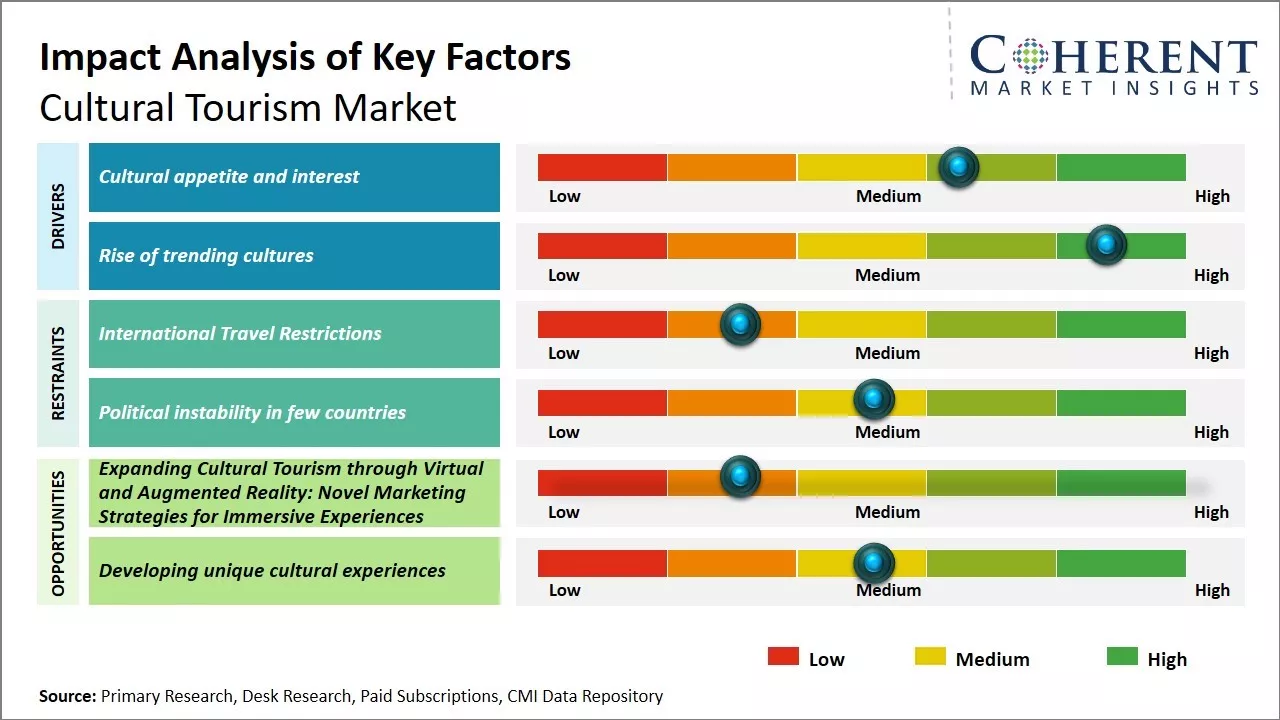
Discover market dynamics shaping the industry: Download Free Sample
The cultural tourism market has been witnessing significant growth over the past few years. Factors such as increasing disposable income, growing millennial population with high spending power, shift in preferences of travelers towards unique experiences, and globalization have been driving the demand for cultural tourism. Furthermore, many destinations have been recognized on the global map for their culture, heritage and traditions, attracting millions of cultural tourists annually. Government support through initiatives aimed at promotion of local culture and investments in cultural infrastructure have further boosted cultural tourism. However, intense competition among destinations and global economic slowdowns remain challenges for industry players in the market.
Cultural appetite and interest
With globalization connecting different parts of the world, people have become more curious about other cultures and civilizations. There is a growing desire among travelers to immerse themselves in new cultural experiences and understand different ways of life. People want to learn about the historic sites, architectures, arts, festivals, cuisines and traditions that make each destination unique. They no longer see travel just as a form of leisure or escape, but as an opportunity for cultural enrichment.
This rising cultural interest has led more people to plan trips focused on exploring the cultural heritage and creative culture of places. They want to engage in activities like attending performances, visiting ancient monuments and museums, joining local events and workshops. Understanding cultures through direct experience offers them satisfaction that generic sightseeing cannot. It allows people to establish meaningful connections with destinations and appreciate diverse worldviews. The cultural tourism sector has skillfully tapped into this demand by curating attractive cultural tours and experiences. Destinations are also promoting their rich cultural assets proactively to draw such visitors.
Market Concentration and Competitive Landscape
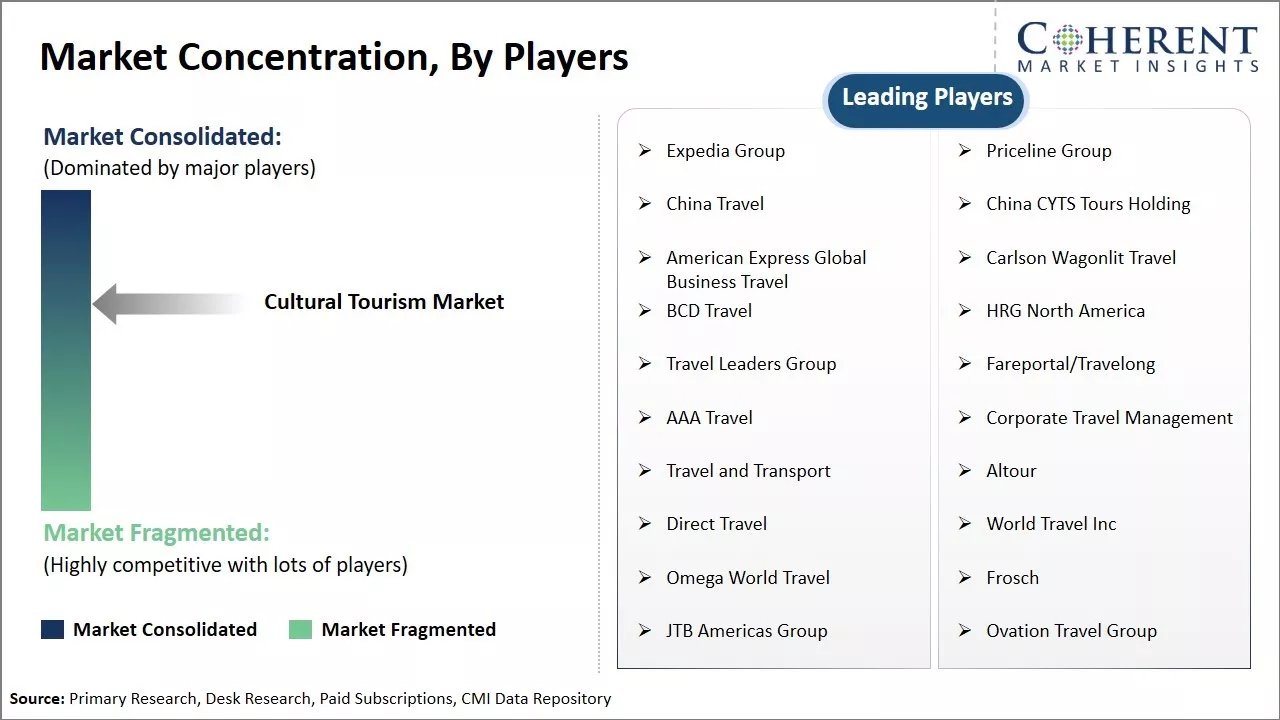
Get actionable strategies to beat competition: Download Free Sample
Rise of trending culturesIn today's interconnected world, certain cultures are gaining widespread popularity and global acclaim for their arts, philosophy, and way of life. Their popularity is augmented by trends in film, music, cuisine, spirituality, etc. that expose diverse cultures to a global audience. This has made these cultures magnets for travelers intrigued to sample their allure. Experiencing rising trending cultures live allows people to feel part of significant global cultural movements and feed their desire to engage with current cultural zeitgeists. Some examples that have witnessed a boom in cultural tourism include Japanese culture driven by the popularity of anime, Korean wave due to K-dramas and Asian cuisine, Moroccan and Spanish cultures owing to influences in fashion and interior design, etc.
Destinations closely associated with cultures achieving global trending status have cleverly cashed in on this opportunity. They promote signature elements of their cultures vigorously to attract interested crowds. Festivals, workshops, and immersive neighborhoods recreate the spirit of these cultures attractively. The infrastructure and tourist experience is also tuned to cater to needs of culturally-focused visitors. As long as certain cultures keep gaining worldwide reverence and influence, they will continue propelling more travelers to their spiritual homes and sustaining momentum in cultural tourism for relevant destinations.
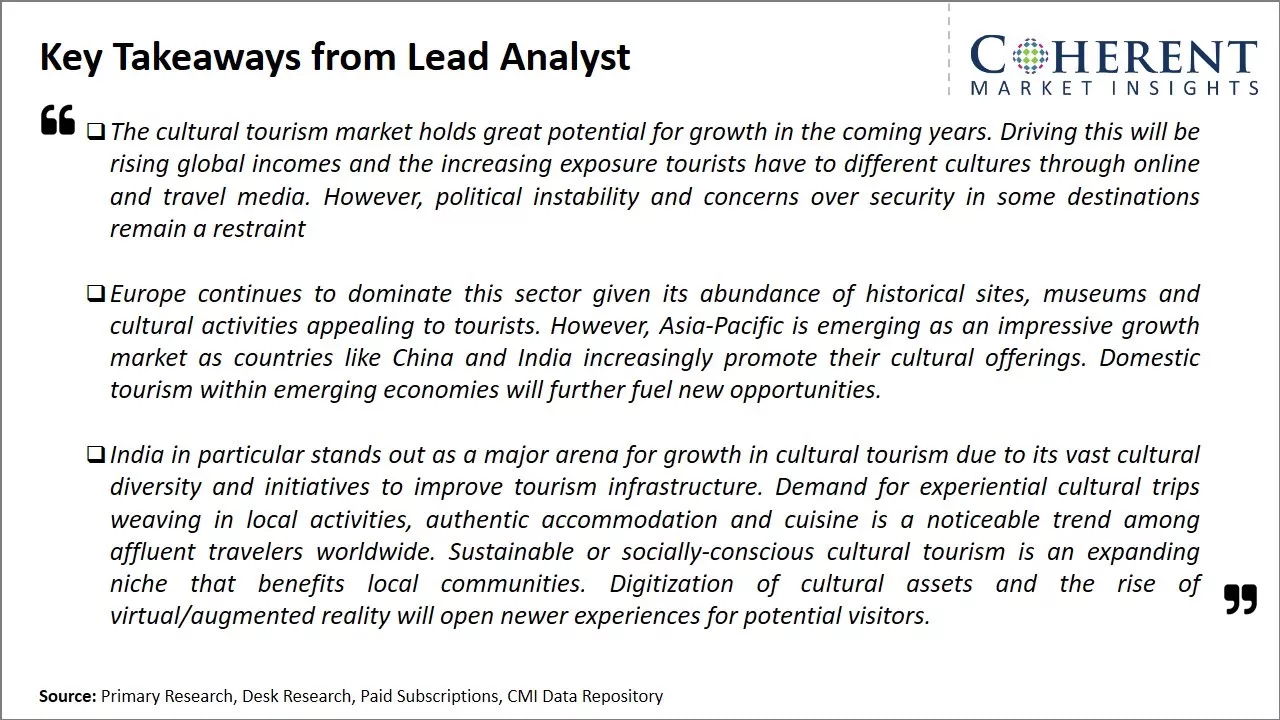
To learn more about this report, Download Free Sample
Market Challenges: International Travel RestrictionsThe cultural tourism market faces several challenges. Due to the ongoing pandemic, international travel restrictions have limited people's ability to visit cultural attractions in other countries. Cultural sites have faced financial strain with reduced ticket sales and closures. Younger generations also show less interest in traditional cultural activities and are more attracted to social media and technology. It is difficult for many cultural destinations and artifacts to appeal to modern tourists and compete with other leisure activities for consumers' time and spending.
Market Opportunities: Expanding Cultural Tourism through Virtual and Augmented Reality: Novel Marketing Strategies for Immersive Experiences
Domestic cultural tourism within countries is growing as people seek out local experiences. Virtual and augmented reality technologies can be leveraged to immerse people in cultural events and destinations without physical travel. Cultural experiences can be marketed in more novel ways such as through social media influencers or partnerships with popular streaming and gaming platforms.
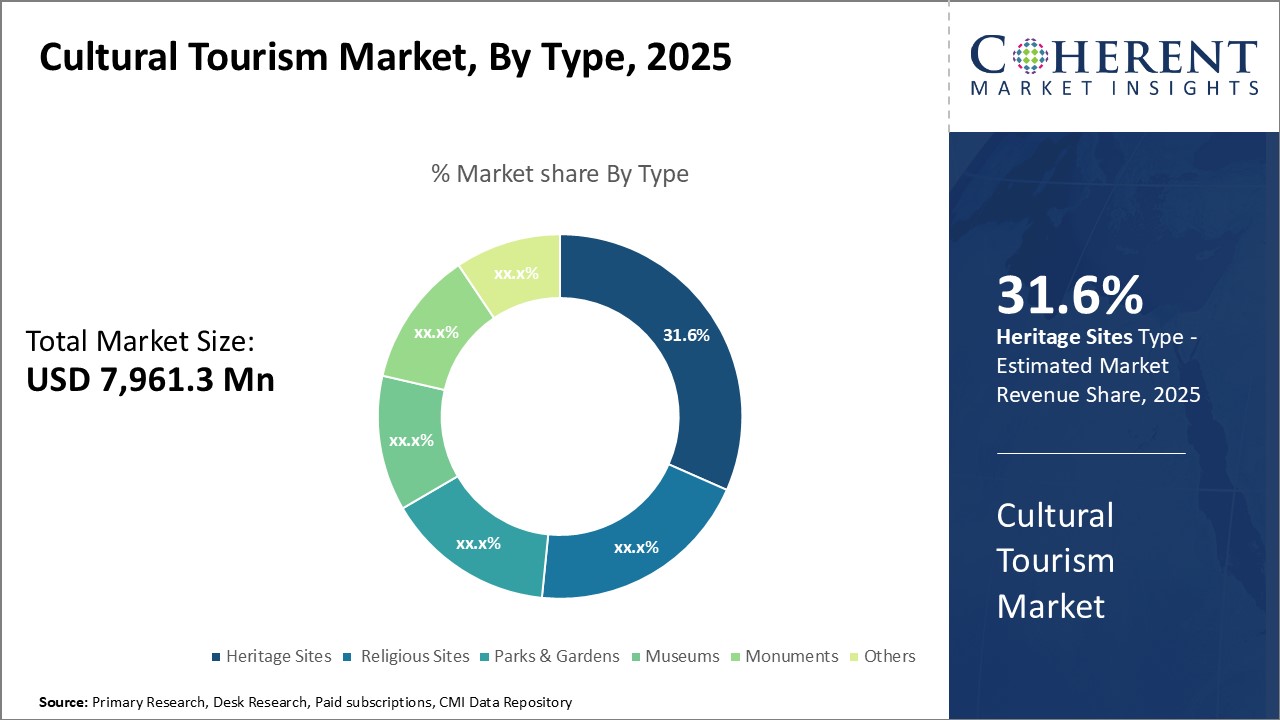
Discover high revenue pocket segments and roadmap to it: Download Free Sample
Insights, By Type: Cultural Richness Fuels Growth in Heritage SitesHeritage sites attract the 31.6% share of the cultural tourism market owing to the immense cultural richness embodied at these locations. Spanning centuries of history, heritage sites offer tourists a glimpse into the cultural traditions, architectural styles, and artistic influences that shaped civilizations. More than just structures of historical significance, heritage sites transport visitors back in time through their intricate details and contextual displays. The allure of uncovering lesser known facets of the past fuels repeat visits to heritage sites and drives consistent growth in this segment. Heritage sites dedicated to specific eras or ruling dynasties impart a rich cultural education. For instance, visitors walking through the ornate corridors and courtyards of American heritage sites relive defining moments in the colonial history. In India, heritage forts and palaces transported well to revive the splendor and grandeur of bygone empires. The architectural magnificence and cultural legacy preserved at these locations attract history and architecture buffs from around the world. Living history museums reconstructing life through different periods further strengthen the cultural learning at heritage sites.
Insights, By Purpose of Visit: Pursuit of Inner Peace Uplifts Religious Sites
Religious sites commanding the second largest share trace their popularity to the inner peace sought by cultural tourists at these locations with 31.8% share. Sacred places of worship immerse visitors in an atmosphere of spirituality and divine tranquility. Be it paying homage at hallowed shrines or absorbing the serenity of sacred architecture, religious sites offer an escape from mundane stresses of modern life. The chance to reflect on life's meaningful pursuits and rejuvenate the soul lifts cultural tourism to these segments. Major faith-based circuits across the world witness growing footfalls each year in pursuit of inner wellness. Holy cities central to world religions attract pilgrims throughout the year with their spiritual energy and aesthetic grandeur of temples or mosques. Significant dates on religious calendars further spike cultural tourism as believers gather to commemorate. Even free-spirited travelers seeking existential answers are drawn by the mindfulness cultivated in religious environments. Guided prayer sessions, satsangs and yoga workshops enhance the soulful experience.
Insights, By Traveler Type: Thrill of Exploration Buoys Solo Travelers
Within cultural tourism segments classified by traveler type, solo travelers currently forming the 31.7% share can be attributed to their thrill of exploration. Breaking away from preset itineraries and packaged activities, independent cultural travels offer unprecedented freedom to explore destinations based on personal interests and whims. The unmatched flexibility and absence of group compromises light a spark of adventure in solo cultural tourists. Traversing heritage trails, spiritual circuits or museum trails alone allows immersive engagements free of distractions. Chance encounters with like-minded travelers along the way enrich experiences. Successfully navigating foreign lands solo boosts self-assurance while digging deeper into local communities off the tourist track satisfies the craving for authentic cultural immersion. Mastering new photography techniques to capture destinations from unique angles also motivates solo travel among culture vultures.
Regional Insights
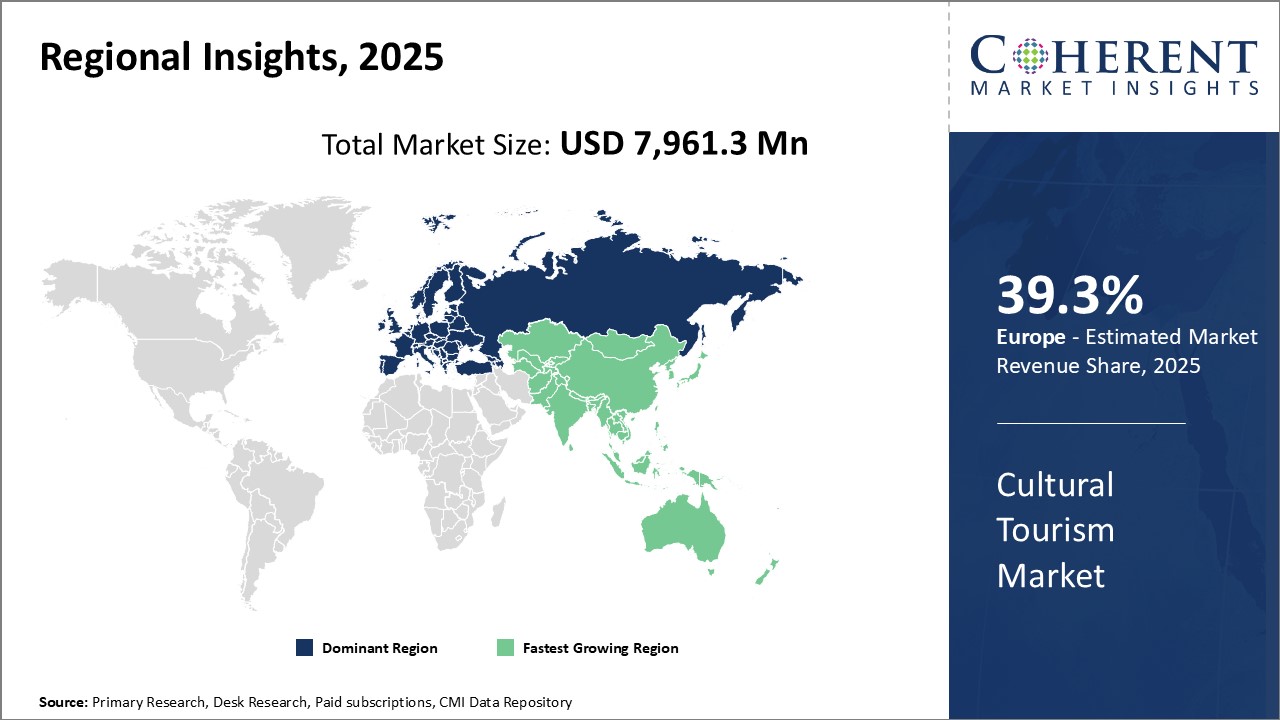
Need a Different Region or Segment? Download Free Sample
The European region, consisting major economies like France, Italy, Germany and U.K., has been dominating the global cultural tourism market for decades with 39.3% share. The rich cultural heritage sites across these countries attract millions of tourists annually. France alone receives over 80 million foreign tourists every year, many of whom come to explore the magnificent landmarks in and around cities like Paris, Lyon, and Nice. The excellent transport and hospitality infrastructure in Western European nations ensure tourists can seamlessly travel within the region and immerse themselves in the local culture. Several cities offer different cultural experiences throughout the year in the form of art fairs, music festivals, and culinary events, keeping the tourism market vibrant. The strong government support through initiatives like heritage preservation funds and tourism promotion boards has also aided the growth of cultural tourism industry in Europe.
The Asia Pacific region has emerged as one of the fastest growing cultural tourism markets globally in recent years. Countries like Thailand, Malaysia, Vietnam, and Philippines have witnessed double digit annual growth in tourist arrivals over the past decade. Multiple factors have contributed to this surge, the most important being the unique mix of cultural influences in the region. The rich Asian traditions combined with inputs from colonial rulers like the British, Portuguese and Dutch have led to the development of distinct cultures in various Southeast Asian destinations. Their relatively lower costs have also made the region an attractive options for global tourists looking for exotic cultural experiences at affordable prices. Furthermore, the impressive infrastructure growth, especially in transportation and accommodation sectors, has enhanced the travel experience. If the governments continue prioritizing tourism sector development, Southeast Asia is well-positioned to dominate the cultural tourism industry worldwide in the coming years.
Market Report Scope
Cultural Tourism Market Report Coverage
| Report Coverage | Details | ||
|---|---|---|---|
| Base Year: | 2024 | Market Size in 2025: | USD 7,961.3 Mn |
| Historical Data for: | 2020 To 2024 | Forecast Period: | 2025 To 2032 |
| Forecast Period 2025 to 2032 CAGR: | 14.5% | 2032 Value Projection: | USD 20,553.7 Mn |
| Geographies covered: |
|
||
| Segments covered: |
|
||
| Companies covered: |
Expedia Group, Priceline Group, China Travel, China CYTS Tours Holding, American Express Global Business Travel, Carlson Wagonlit Travel, BCD Travel, HRG North America, Travel Leaders Group, Fareportal/Travelong, AAA Travel, Corporate Travel Management, Travel and Transport, Altour, Direct Travel, World Travel Inc, Omega World Travel, Frosch, JTB Americas Group, and Ovation Travel Group |
||
| Growth Drivers: |
|
||
| Restraints & Challenges: |
|
||
Uncover macros and micros vetted on 75+ parameters: Get instant access to report
Market Segmentation
- Type Insights (Revenue, USD Mn, 2020 - 2032)
- Heritage Sites
- Religious Sites
- Parks & Gardens
- Museums
- Monuments
- Others
- Purpose of Visit Insights (Revenue, USD Mn, 2020 - 2032)
- Pilgrimage
- Leisure
- Educational/Study
- Photography/Art
- Others
- Traveler Type Insights (Revenue, USD Mn, 2020 - 2032)
- Solo Travelers
- Friends/Families
- Others
- Regional Insights (Revenue, USD Mn, 2020 - 2032)
- North America
- U.S.
- Canada
- Latin America
- Brazil
- Argentina
- Mexico
- Rest of Latin America
- Europe
- Germany
- U.K.
- Spain
- France
- Italy
- Russia
- Rest of Europe
- Asia Pacific
- China
- India
- Japan
- Australia
- South Korea
- ASEAN
- Rest of Asia Pacific
- Middle East & Africa
- GCC Countries
- Israel
- Rest of Middle East & Africa
- North America
- Key Players Insights
- Expedia Group
- Priceline Group
- China Travel
- China CYTS Tours Holding
- American Express Global Business Travel
- Carlson Wagonlit Travel
- BCD Travel
- HRG North America
- Travel Leaders Group
- Fareportal/Travelong
- AAA Travel
- Corporate Travel Management
- Travel and Transport
- Altour
- Direct Travel
- World Travel Inc
- Omega World Travel
- Frosch
- JTB Americas Group
- Ovation Travel Group
Share
Share
Missing comfort of reading report in your local language? Find your preferred language :
Transform your Strategy with Exclusive Trending Reports :
Frequently Asked Questions
EXISTING CLIENTELE
Joining thousands of companies around the world committed to making the Excellent Business Solutions.
View All Our Clients
